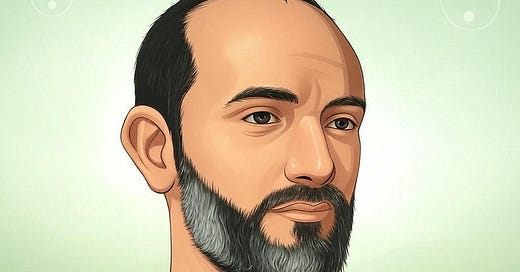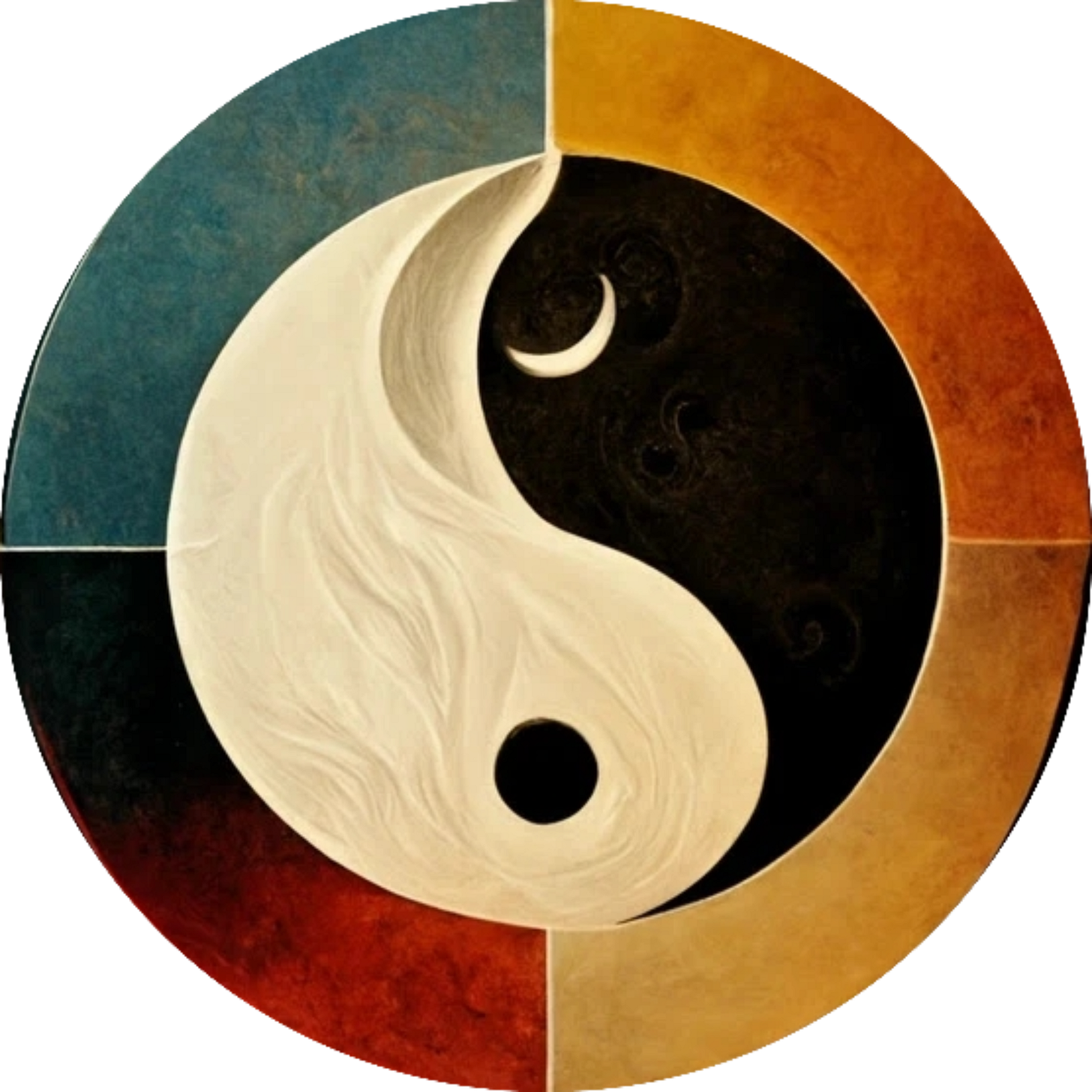As you might have seen, I decided to return to writing last week. At the same time, however, the flu visited me. To make it even worse, after the flu left, bronchitis decided to come over, and I couldn’t get rid of him. So, it’s been about a week of on-and-off-again low-grade fevers, a constant flow of pills, and a lot of coughing.
Every time I came to the computer to write, either one of my kids needed something, I had to go somewhere, or any of the other 5,000 things that kept me from writing.
But here I am. Pushing through it.
First, I’ve started my Substack chat, and I’m taking suggestions for what topics my readers would like to see. Thank you to
for the suggestion!The Yin-Yang is one of the most recognized symbols in the world. Yin is white, and Yang is black. Yin represents the feminine, and Yang represents the masculine. Yin knows how to give, and Yang knows how to take. You can use one million different examples, and they’re all correct. Yin and Yang rotate forever in an endless cycle. In fact, writing them separately as Yin and Yang is incorrect. It’s important to remember that one aspect can not exist without the other, and neither is better nor more powerful. That’s why they are one and the same - Yinyang.
Too often, we are caught in the political dogma of one group vs another. Toxic masculinity vs. feminism, for example. Arguments over which group is better or worse are nonsense, as each is a reflection of the other. You can’t battle toxic masculinity without empowering women to be proud of who they are. At the same time, you can’t overcome the hate extreme feminism produces without making sure young men feel safe to express their thoughts and feelings without the fear of being labeled a misogynist. It’s not as simple as stating Yin and Yang are opposites of each other or a reaction to each other. If your head is head cut off, you’ll have a head and a body, but both parts are dead now. The parts can’t exist without each other.
Just as your head and your body are both you, Yin and Yang ARE Yingyang. One system, one being. Forever rotating.
On a broad level, the entire universe operates in the same manner. Stars are created by gas and matter smashing into each other due to their gravity. After billions of years, stars explode and leave behind a gas, creating new stars, which explode into gas, and the cycle continues. Trillions and trillions of years will pass before this cycle stops, assuming it ever does. There’s a philosophical argument to be made that if everything exists in cycles, then why should the universe die and not restart? What about us? But I digress.
When I examine my life, I see clear cycles. For example, I used to joke with my coworkers that I was either in an “I want to be at home” phase or an “I want to be at work” phase, depending on which part of my life was crazier than the other. With three little children at home, driving into the office was a welcome escape. Now, my little kids are teenagers and becoming more independent, so I enjoy the time I get to spend with them. Every few years, the situation changes, and my preference returns to where it was.
You can read endless books or watch a million YouTube videos about Yinyang. So, the only story I can write about Yinyang that no one else can, and you won’t be able to find in a YouTube video, is my connection to Yinyang. The following is a selection from an article I wrote called The Boy and the Yin-Yang.
Once upon a time, there was a boy who was ten years old. He liked his family’s new computer because it had a color screen and a mouse. But most of all, it had a paint program. He loved MS Paint, and during his summer days, he would find national flags, symbols, and logos to draw into Paint. He drew the Texas flag first, which was his home state, then the United States, something called NATO, which seemed easy enough, and China, Russia, and Colorado for his mother. But one day, he found a strange circular symbol with only two colors; black and white. The two colors seemed to be swirling into the center as if neither one could overtake the other. When his big brother came home, the boy asked, “What is this symbol?” His brother replied, “Oh, that’s a yin-yang.” “What is it for?” asked the boy. “I’m not sure, but I think it means opposites or balance or something,” his older brother quickly replied as he walked off. The boy loved this MS Paint picture most of all. He wasn’t sure why or where the yin-yang came from or even what it meant, but he liked it deeply. And for many years, he remembered that drawing he created one day in MS Paint.
Fast Forward. The boy is now 19 years old. A fan of Winnie the Pooh since before his MS Paint adventure, a friend asked if he had ever heard of a book named “The Tao of Pooh,” to which he replied simply, “No.” “I think you would like it,” the friend said. The boy looked in the library, but it was checked out. He also didn’t have money since he was a poor college student. He asked his girlfriend to buy it for him for his birthday, but instead, she bought another Pooh book about business and success. The boy didn’t like those books as he read a few pages and then never picked them up again.
Fast Forward. The boy is now 37 years old, married, has three kids, two dogs, and possibly testicular cancer. Times are hard. He attends a local arts and jazz festival with his wife to attempt to relax and not stress too much. At the festival, he finds a vendor that sells handmade necklaces made of bone. He notices that one of the necklaces has a yin-yang. The boy remembers using MS Paint all those years ago. He remembers almost buying the Tao of Pooh all those years ago. He remembers that yin-yang has something to do with Taoism, which he had understood from researching the Pooh book. Several months later, he discovered it wasn’t cancer but a rare mass of non-cancerous cells, but surgery was still required.
During recovery, the boy began researching this yin-yang he was now wearing. He found out it was Chinese, and it could be found in nature. He found an entire sect of Westerners who follow Taoist teachings and philosophy. He discovered discord servers, websites, YouTubers, and online classes. He read every copy of translated ancient books like the Tao Te Ching and Zhuangzu. He discovered he loved reading non-Harry Potter books for the first time in his life! He read anything he could from anyone, including Alan Watts. He joined online communities, joined classes from George Thompson, and built friendships online, and… it was good. He felt his life had been enriched again, like when he married and had children. New opportunities presented themselves, and new relationships began. Life slowed down, and a calm routine set in.
Fast forward. The boy is now 40 years old. He developed tinnitus and, for the past year, has struggled with anxiety attacks, lack of sleep, and medications that wreak havoc on his meditation, practice, and peace of mind. What was once beautiful peace and quiet had become a high-pitched squeal 24 hours a day, seven days a week, with no breaks…ever. Through many weeks, he was able to gain the upper hand on the condition. Sleeping became a regular occurrence, but the damage had already been done. He left the communities, stopped learning, sat alone in a house, and wondered if peace would find him again.
One day he joined a new social network called Mastodon. He looked for a Taoist community but couldn’t find one. He rejoined his old Discord server, which he was left an administrator over, and discovered the ability to stand up and manage a Mastodon instance wasn’t as hard as he thought. There were certainly Taoists on Mastodon, but no instance to call home. He wanted to share his story and everything he had learned. He hoped that maybe if he shared what he had learned, he could find a different path forward. He knew his journey wasn’t over, he was just slowing down. Sharing his thoughts and feelings wouldn’t be a miracle cure for anything, and he couldn’t promise to help anyone do anything differently.
After all, he remembered drawing the yin-yang on MS Paint all those years ago. If the yin-yang, and thereby the Tao, could speak to him, guide him, and show itself to him, then perhaps it could do the same for others. They just need a place to find it. And so, the boy created The Taoist Corner.
Thank you for reading, everyone! If you want to read more of my work, I published a book last year that discusses Tao’s reflection on my life and my journey through the hardships of living. You can find it below on Amazon if you want to support me. I don’t paywall my articles, but I would appreciate any help you can give.
Or, if you want to help me every month or even once a year, please consider becoming a paid subscriber. I’ll give you a personal shoutout on each article! If you’re also a writer, it could be a great way to help get the word out about your work on Substack.
A big thank you to my first paid subscriber, Tracy!
And my second paid subscriber, Debra!
Here is a discount for just reading this all the way to the bottom.
I’ll write again soon!








The tinnitus must have been deeply distracting. I’m sorry to hear you had bronchitis this week. It always rattles my head when I get a bad cough.
I liked the yinyang you drew as a child on MS Paint. I appreciate beginning to read the Taoist corner.